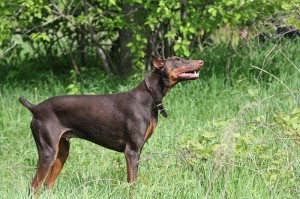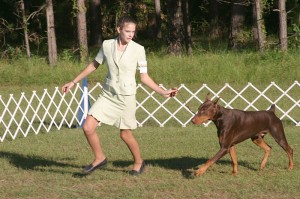 The Doberman Pinscher was created from a mix of German hunting dogs. Later it was used to perform duties as a watchdog and bodyguard. It was bred to be fearless, intimidating, aggressive, and ferocious, to complete the role as a personal protection dog, police dog, and war dog. Later the Doberman was used for tracking, sentry, guarding, police work, military work, and search and rescue (SAR). These canines are not used as much today in these roles as other breeds replaced them. The breed has since been refined into the Doberman it is today.
The Doberman Pinscher was created from a mix of German hunting dogs. Later it was used to perform duties as a watchdog and bodyguard. It was bred to be fearless, intimidating, aggressive, and ferocious, to complete the role as a personal protection dog, police dog, and war dog. Later the Doberman was used for tracking, sentry, guarding, police work, military work, and search and rescue (SAR). These canines are not used as much today in these roles as other breeds replaced them. The breed has since been refined into the Doberman it is today.
Most breeders are now selecting for a less aggressive dog that can fit well into a companion dog environment. Changing the inherited traits of a breed can be a slow process taking many generations to evolve. Although improvements can be seen, there are Doberman Pinschers that still possess the older characteristics. It is important to keep in mind that both types of Doberman Pinscher bloodlines still exist today in Europe and America. Bloodlines should be determined before selecting a Doberman Pinscher as a family pet.
The Doberman is by nature sensitive and prone to varying degrees of neophobia (fear of new things). Even today’s companion-bred dogs retain the breed’s original active defense reflex. Thorough socialization to ingrain the world as a safe and pleasant place is essential, as are reward-based training methods. If a Doberman is not well socialized, or if it’s handled or trained with harsh methods, it can easily develop defensive fear aggression. The dog can become aggressive towards strangers and other dogs. Combined with their strength and size, this makes them potentially dangerous especially to non family members and unfamiliar dogs. The fashion of cropping ears and tail can make it difficult to read the Doberman’s mood and see when it is anxious or otherwise uncomfortable in a given situation. The  Doberman is not recommended for a family with children, an elderly person, or anyone with disabilities.
Doberman is not recommended for a family with children, an elderly person, or anyone with disabilities.
The Doberman is an intelligent dog. As long as non-aversive training methods are used, Dobermans are quick to learn. They are playful, curious, and versatile. Despite the change in disposition through generations, they are still agile, powerful, and strong. They are energetic with an impressive stamina and need daily walks or jogs with a strong fit owner. Doberman Pinschers need to be properly socialized, and obedience trained. They bond well with owners who treat them well and may exhibit protective qualities in various situations.
The Doberman weighs about 60-90 pounds. They are average shedders and need very little grooming. Their coats are not suitable for cold climates and they do best as indoor pets. They are prone to health issues, such as dilated cardiomyopathy, cervical vertebral instability, Von Willebrand’s disease, canine compulsive disorder (in particular flank sucking), prostatic disease, hypothyroidism, and hip dysplasia. Their lifespan can be about 13 years, unless they die of failure of the all too common enlarged heart**.
** Prevalence of Dilated Cardiomyopathy in Doberman Pinschers in Various Age Groups, G. Wess, A. Schulze, V. Butz, J. Simak, M. Killich, L.J.M. Keller, J. Maeurer, and, K. Hartmann, Journal of Veterinary Internal Medicine, May/June 2010; Vol 24; Issue 3; pp 533 – 538.

Could I add a couple things to emphasize the extra mile Doberman owners have to take? The breed was created by Karl Friedrich Louis Dobermann, a tax collector who wanted a dog to ward off thieves when he went on his rounds. So the dog walked long distances with him each day, transferring the modern Doberman’s need for a lot of exercise. And even if the breed has been made calmer these days, it was made for protection, so it absolutely holds the potential for aggression. It’s also believed greyhounds were mixed in with this breed’s heritage, so they’re fast.
If someone likes the look of Dobermans but doesn’t want to deal with the size, excessive exercise, and potential aggression, they might want to look into a miniature pinscher, German pinscher, or Manchester terrier. The latter two have “terrier” issues such as destructiveness if they get bored and a prey drive, and they do need their exercise. But they’re medium-sized and were bred for hunting vermin rather than guarding. Manchesters come in black and tan, and minpins and German pinschers can also be red. Minpins are toy breeds (companions), and the other two were made before Dobermans, so their original bloodlines don’t have Doberman in them.